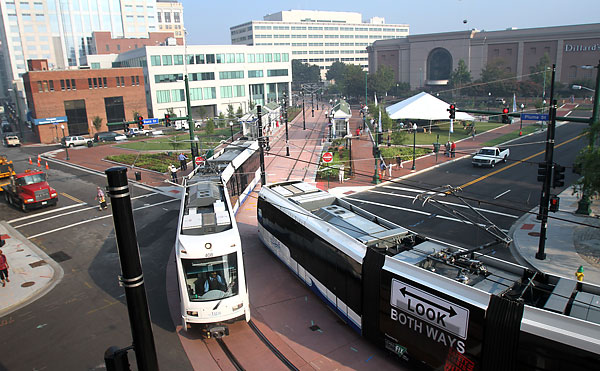The Tide light rail opened today. According to the guys at Skyscraper Page it was $350m for 11.4 kilometers (=7.08 miles), or just over $30m/kilometer (=just under $50m/mile). Daily ridership is projected to be 12k-15k initially, which gives us a ridership of 1k-1.3k/kilometer (=1.7k-2.1k/mile). Or, for far more useful calculation: there are 11 stations on the line, which gives us 1.09k-1.36k trips generated per station, or $23k-$29k spent per rider.
And of course, since it is in highly urbanized downtown Norfolk, and ridership projections in these United States routinely underproject urban ridership by a factor of half (and routinely overproject suburban ridership by double), we have to refine our numbers to reflect that the real ridership of this line, after five years, will be closer to 25k, which gives us a ridership just under 2.2k/kilometer (=3.5k/mile), or an average station ridership of 2.27k, or an initialization cost of $14k/passenger.
The Tide is an electrified light rail line using Siemens S70s and substantial street running. I am certain there's an American premium tacked onto the S70 price (although it should be no more than the per-unit cost of e.g. Portland's or Houston's S70 orders*), but the overall costs seem extremely low, by American standards, and thus very reasonable, by global standards.
One last note: The Tide's current routing has two obvious extensions. The shorter, but possibly more expensive, and definitely generating higher ridership, is further north, past Old Dominion University to the Norfolk Naval Station, presumably mostly along VA 337. The longer and cheaper--but given the suburban terrain, less likely to generate higher ridership--follows what is apparently an old rail grade the current light rail line picks up between Harbor Park and Norfolk State University stations; this easement is a straight shot east from the current Newtown Road terminus all the way to Virginia Beach's beach.
In the long run, this extended Tide route would work best paired with another line running at least from Norfolk International Airport--preferably the Lynnhaven Roads, if not Fort Story--down to at least the Norfolk Naval Shipyard, if not Deep Creek, and a third line that would originate at the Chesapeake Square Mall, run through downtown Portsmouth with some interlining with the second line, and branch northwest to Churchland (first the shopping center, and then the Coast Guard base) and/or northeast to Virginia Wesleyan College and/or the international airport (possibly interlined with the second line). A final possibility to be considered is a line down the Virginia Beach spine, connecting with the second line up at Ft. Story and the first line just south of downtown Virginia Beach, and running down to Landstown via Virgina Beach Municipal Center with a possible branch to Sandbridge Beach via the Training Support Center; no route has been considered to Newport News, due to the inordinate expense of a cross-Roads connection. In all, though, the Hampton Roads are a classically "New South" metropolitan area--almost pure sprawl--and so any any further quality transit in the area is going to either have to take on the goal of densifying near itself or else surrounding itself with insurmountable park-and-rides.
Whatever the folks in Norfolk are doing right, it would make sense for other transit agencies to follow.
_________________
* If the Wikipedia numbers are to be trusted, it will cost Atlanta $17.2m for four units. That would make the cost per unit $4.3m, implying that the Tide order (nine units) must have been roughly $38.7m (or just over 1/10 the total cost).



No comments:
Post a Comment